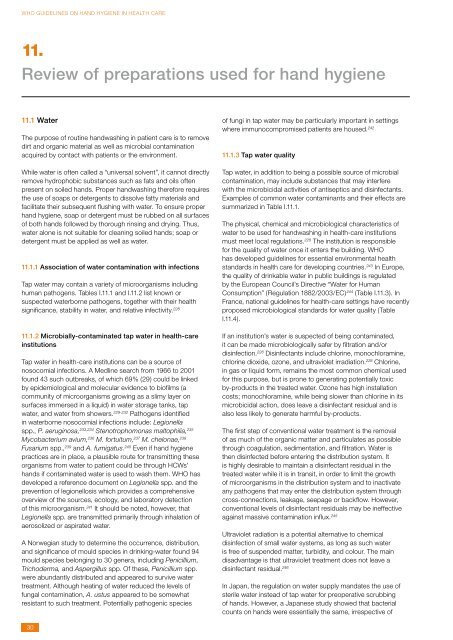WHO Guidelines on Hand Hygiene in Health Care - Safe Care ...
WHO Guidelines on Hand Hygiene in Health Care - Safe Care ...
WHO Guidelines on Hand Hygiene in Health Care - Safe Care ...
Create successful ePaper yourself
Turn your PDF publications into a flip-book with our unique Google optimized e-Paper software.
<str<strong>on</strong>g>WHO</str<strong>on</strong>g> GUIDELINES ON HAND HYGIENE IN HEALTH CARE<br />
11.<br />
Review of preparati<strong>on</strong>s used for hand hygiene<br />
11.1 Water<br />
The purpose of rout<strong>in</strong>e handwash<strong>in</strong>g <strong>in</strong> patient care is to remove<br />
dirt and organic material as well as microbial c<strong>on</strong>tam<strong>in</strong>ati<strong>on</strong><br />
acquired by c<strong>on</strong>tact with patients or the envir<strong>on</strong>ment.<br />
While water is often called a “universal solvent”, it cannot directly<br />
remove hydrophobic substances such as fats and oils often<br />
present <strong>on</strong> soiled hands. Proper handwash<strong>in</strong>g therefore requires<br />
the use of soaps or detergents to dissolve fatty materials and<br />
facilitate their subsequent flush<strong>in</strong>g with water. To ensure proper<br />
hand hygiene, soap or detergent must be rubbed <strong>on</strong> all surfaces<br />
of both hands followed by thorough r<strong>in</strong>s<strong>in</strong>g and dry<strong>in</strong>g. Thus,<br />
water al<strong>on</strong>e is not suitable for clean<strong>in</strong>g soiled hands; soap or<br />
detergent must be applied as well as water.<br />
11.1.1 Associati<strong>on</strong> of water c<strong>on</strong>tam<strong>in</strong>ati<strong>on</strong> with <strong>in</strong>fecti<strong>on</strong>s<br />
Tap water may c<strong>on</strong>ta<strong>in</strong> a variety of microorganisms <strong>in</strong>clud<strong>in</strong>g<br />
human pathogens. Tables I.11.1 and I.11.2 list known or<br />
suspected waterborne pathogens, together with their health<br />
significance, stability <strong>in</strong> water, and relative <strong>in</strong>fectivity. 228<br />
11.1.2 Microbially-c<strong>on</strong>tam<strong>in</strong>ated tap water <strong>in</strong> health-care<br />
<strong>in</strong>stituti<strong>on</strong>s<br />
Tap water <strong>in</strong> health-care <strong>in</strong>stituti<strong>on</strong>s can be a source of<br />
nosocomial <strong>in</strong>fecti<strong>on</strong>s. A Medl<strong>in</strong>e search from 1966 to 2001<br />
found 43 such outbreaks, of which 69% (29) could be l<strong>in</strong>ked<br />
by epidemiological and molecular evidence to biofilms (a<br />
community of microorganisms grow<strong>in</strong>g as a slimy layer <strong>on</strong><br />
surfaces immersed <strong>in</strong> a liquid) <strong>in</strong> water storage tanks, tap<br />
water, and water from showers. 229-232 Pathogens identified<br />
<strong>in</strong> waterborne nosocomial <strong>in</strong>fecti<strong>on</strong>s <strong>in</strong>clude: Legi<strong>on</strong>ella<br />
spp., P. aerug<strong>in</strong>osa, 233,234 Stenotrophom<strong>on</strong>as maltophilia, 235<br />
Mycobacterium avium, 236 M. fortuitum, 237 M. chel<strong>on</strong>ae, 238<br />
Fusarium spp., 239 and A. fumigatus. 240 Even if hand hygiene<br />
practices are <strong>in</strong> place, a plausible route for transmitt<strong>in</strong>g these<br />
organisms from water to patient could be through HCWs’<br />
hands if c<strong>on</strong>tam<strong>in</strong>ated water is used to wash them. <str<strong>on</strong>g>WHO</str<strong>on</strong>g> has<br />
developed a reference document <strong>on</strong> Legi<strong>on</strong>ella spp. and the<br />
preventi<strong>on</strong> of legi<strong>on</strong>ellosis which provides a comprehensive<br />
overview of the sources, ecology, and laboratory detecti<strong>on</strong><br />
of this microorganism. 241 It should be noted, however, that<br />
Legi<strong>on</strong>ella spp. are transmitted primarily through <strong>in</strong>halati<strong>on</strong> of<br />
aerosolized or aspirated water.<br />
A Norwegian study to determ<strong>in</strong>e the occurrence, distributi<strong>on</strong>,<br />
and significance of mould species <strong>in</strong> dr<strong>in</strong>k<strong>in</strong>g-water found 94<br />
mould species bel<strong>on</strong>g<strong>in</strong>g to 30 genera, <strong>in</strong>clud<strong>in</strong>g Penicillium,<br />
Trichoderma, and Aspergillus spp. Of these, Penicillium spp.<br />
were abundantly distributed and appeared to survive water<br />
treatment. Although heat<strong>in</strong>g of water reduced the levels of<br />
fungal c<strong>on</strong>tam<strong>in</strong>ati<strong>on</strong>, A. ustus appeared to be somewhat<br />
resistant to such treatment. Potentially pathogenic species<br />
of fungi <strong>in</strong> tap water may be particularly important <strong>in</strong> sett<strong>in</strong>gs<br />
where immunocompromised patients are housed. 242<br />
11.1.3 Tap water quality<br />
Tap water, <strong>in</strong> additi<strong>on</strong> to be<strong>in</strong>g a possible source of microbial<br />
c<strong>on</strong>tam<strong>in</strong>ati<strong>on</strong>, may <strong>in</strong>clude substances that may <strong>in</strong>terfere<br />
with the microbicidal activities of antiseptics and dis<strong>in</strong>fectants.<br />
Examples of comm<strong>on</strong> water c<strong>on</strong>tam<strong>in</strong>ants and their effects are<br />
summarized <strong>in</strong> Table I.11.1.<br />
The physical, chemical and microbiological characteristics of<br />
water to be used for handwash<strong>in</strong>g <strong>in</strong> health-care <strong>in</strong>stituti<strong>on</strong>s<br />
must meet local regulati<strong>on</strong>s. 228 The <strong>in</strong>stituti<strong>on</strong> is resp<strong>on</strong>sible<br />
for the quality of water <strong>on</strong>ce it enters the build<strong>in</strong>g. <str<strong>on</strong>g>WHO</str<strong>on</strong>g><br />
has developed guidel<strong>in</strong>es for essential envir<strong>on</strong>mental health<br />
standards <strong>in</strong> health care for develop<strong>in</strong>g countries. 243 In Europe,<br />
the quality of dr<strong>in</strong>kable water <strong>in</strong> public build<strong>in</strong>gs is regulated<br />
by the European Council’s Directive “Water for Human<br />
C<strong>on</strong>sumpti<strong>on</strong>” (Regulati<strong>on</strong> 1882/2003/EC) 244 (Table I.11.3). In<br />
France, nati<strong>on</strong>al guidel<strong>in</strong>es for health-care sett<strong>in</strong>gs have recently<br />
proposed microbiological standards for water quality (Table<br />
I.11.4).<br />
If an <strong>in</strong>stituti<strong>on</strong>’s water is suspected of be<strong>in</strong>g c<strong>on</strong>tam<strong>in</strong>ated,<br />
it can be made microbiologically safer by filtrati<strong>on</strong> and/or<br />
dis<strong>in</strong>fecti<strong>on</strong>. 228 Dis<strong>in</strong>fectants <strong>in</strong>clude chlor<strong>in</strong>e, m<strong>on</strong>ochloram<strong>in</strong>e,<br />
chlor<strong>in</strong>e dioxide, oz<strong>on</strong>e, and ultraviolet irradiati<strong>on</strong>. 228 Chlor<strong>in</strong>e,<br />
<strong>in</strong> gas or liquid form, rema<strong>in</strong>s the most comm<strong>on</strong> chemical used<br />
for this purpose, but is pr<strong>on</strong>e to generat<strong>in</strong>g potentially toxic<br />
by-products <strong>in</strong> the treated water. Oz<strong>on</strong>e has high <strong>in</strong>stallati<strong>on</strong><br />
costs; m<strong>on</strong>ochloram<strong>in</strong>e, while be<strong>in</strong>g slower than chlor<strong>in</strong>e <strong>in</strong> its<br />
microbicidal acti<strong>on</strong>, does leave a dis<strong>in</strong>fectant residual and is<br />
also less likely to generate harmful by-products.<br />
The first step of c<strong>on</strong>venti<strong>on</strong>al water treatment is the removal<br />
of as much of the organic matter and particulates as possible<br />
through coagulati<strong>on</strong>, sedimentati<strong>on</strong>, and filtrati<strong>on</strong>. Water is<br />
then dis<strong>in</strong>fected before enter<strong>in</strong>g the distributi<strong>on</strong> system. It<br />
is highly desirable to ma<strong>in</strong>ta<strong>in</strong> a dis<strong>in</strong>fectant residual <strong>in</strong> the<br />
treated water while it is <strong>in</strong> transit, <strong>in</strong> order to limit the growth<br />
of microorganisms <strong>in</strong> the distributi<strong>on</strong> system and to <strong>in</strong>activate<br />
any pathogens that may enter the distributi<strong>on</strong> system through<br />
cross-c<strong>on</strong>necti<strong>on</strong>s, leakage, seepage or backflow. However,<br />
c<strong>on</strong>venti<strong>on</strong>al levels of dis<strong>in</strong>fectant residuals may be <strong>in</strong>effective<br />
aga<strong>in</strong>st massive c<strong>on</strong>tam<strong>in</strong>ati<strong>on</strong> <strong>in</strong>flux. 245<br />
Ultraviolet radiati<strong>on</strong> is a potential alternative to chemical<br />
dis<strong>in</strong>fecti<strong>on</strong> of small water systems, as l<strong>on</strong>g as such water<br />
is free of suspended matter, turbidity, and colour. The ma<strong>in</strong><br />
disadvantage is that ultraviolet treatment does not leave a<br />
dis<strong>in</strong>fectant residual. 246<br />
In Japan, the regulati<strong>on</strong> <strong>on</strong> water supply mandates the use of<br />
sterile water <strong>in</strong>stead of tap water for preoperative scrubb<strong>in</strong>g<br />
of hands. However, a Japanese study showed that bacterial<br />
counts <strong>on</strong> hands were essentially the same, irrespective of<br />
30















